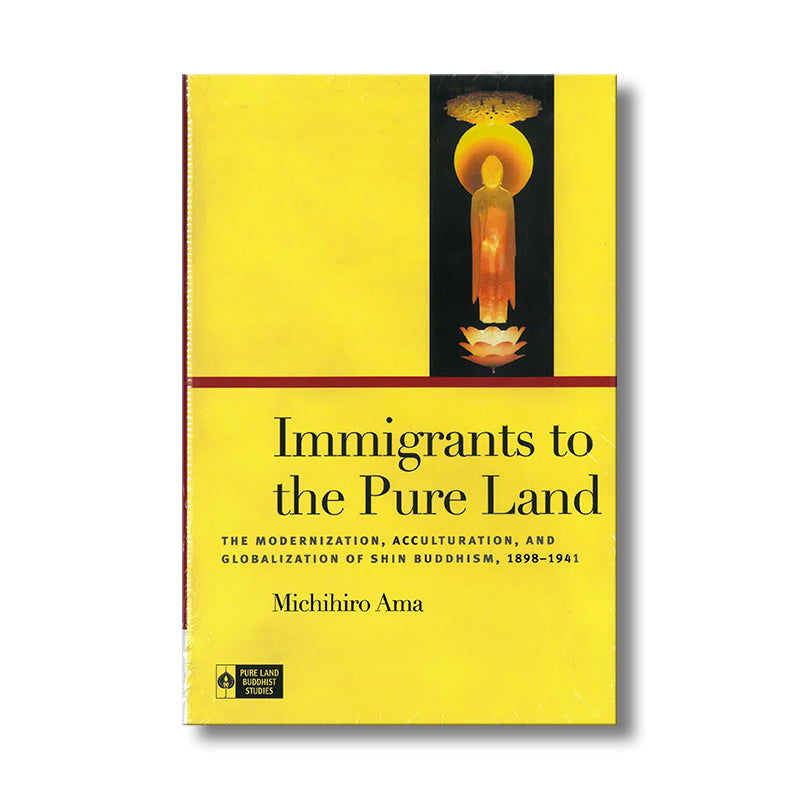Immigrants to the Pure Land
SKU:154388
Couldn't load pickup availability
Product Description
Product Description
Immigrants to the Pure Land : The Modernization, Acculturation, and Globalization of Shin Buddhism, 1898-1941
By Michihiro Ama.
Religious acculturation is typically seen as a one-way process: The dominant religious culture imposes certain behavioral patterns, ethical standards, social values, and organizational and legal requirements onto the immigrant religious tradition. In this view, American society is the active partner in the relationship, while the newly introduced tradition is the passive recipient being changed. Michihiro Ama’s investigation of the early period of Jodo Shinshu in Hawai‘i and the United States sets a new standard for investigating the processes of religious acculturation and a radically new way of thinking about these processes.
Most studies of American religious history are conceptually grounded in a European perspectival position, regarding the U.S. as a continuation of trends and historical events that begin in Europe. Only recently have scholars begun to shift their perspectival locus to Asia. Ama’s use of materials spans the Pacific as he draws on never-before-studied archival works in Japan as well as the U.S. More important, Ama locates immigrant Jodo Shinshu at the interface of two expansionist nations. At the end of the nineteenth and beginning of the twentieth centuries, both Japan and the U.S. were extending their realms of influence into the Pacific, where they came into contact—and eventually conflict—with one another. Jodo Shinshu in Hawai‘i and California was altered in relation to a changing Japan just as it was responding to changes in the U.S. Because Jodo Shinshu’s institutional history in the U.S. and the Pacific occurs at a contested interface, Ama defines its acculturation as a dual process of both “Japanization” and “Americanization.”
Hardbound: 328 pp.
Return Policy
Return Policy
UNLESS FINAL SALE:
Full refunds (less shipping and handling) will be issued provided that the merchandise is in resalable condition upon receipt and the merchandise is returned within 30 days of the delivery date. Before returning any merchandise for a refund or exchange, please email us at museumstore@janm.org. We will provide you with information necessary for the return authorization.
JANM Store Return Policy
Shipping Policy
Shipping Policy
STANDARD DELIVERY: Standard deliveries within the continental U.S. are sent via UPS Ground or USPS Priority Mail from Los Angeles, California. Delivery time varies depending on location and product availability but generally takes from 3-10 business days. You will be advised of a delay in shipping that exceeds 30 days.
JANM Store Shipping Policy
Store Pickup
Store Pickup
The JANM Store is now offering onsite pick-up for orders placed online. Just select “Pick Up in Store” at checkout. You will receive a notification email when your order is ready for pick-up.
Pick-up is by appointment only! Please reply with the date and approximate time you will be picking up your order.
We ask that you pick up your order no later than 10 days after it is ready. If your reply is not received within one week, or you cannot pick up your order within 10 days, your order may be canceled.
We DO NOT guarantee same-day pick-up. Orders received by 3:00 p.m. on a business day will usually be available for pick up by the next available pick-up date. When you arrive at the entrance to the Museum, please call the Store at 888.769.5559, and one of our Sales Associates will bring out your order.
Please allow an extra day for pick-ups on Thanksgiving weekend and the week before Christmas.
We require that you make an appointment for pick up. Appointment times are Tuesday-Saturday 12 p.m.-5 p.m.
Days and hours available for a pick up (subject to change without prior notice).
We are closed on Sundays and Mondays.
Members
Members
Membership in JANM provides numerous benefits (*including 10% off eligible JANM Store purchases!), and supports our mission to promote understanding and appreciation of America’s ethnic and cultural diversity by sharing the experiences of Japanese Americans. Become a new Member, renew your Membership, or share JANM with a friend or loved one by giving a Gift Membership.
Add a membership to your cart and you'll immediately receive 10% off all qualifying items on your order.
Join Today






